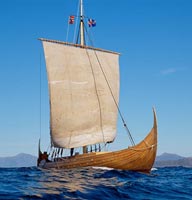 Stepping away for a moment from the unfolding current events in the Ukraine and Russia, it might be worthwhile to look at the history of the region, which was shaped by the arrival of merchant adventurers rowing long ships. As with so much of European history, it began with the Vikings. The Norse Vikings, from the region that we now call Sweden, rowed their long ships deep into the rivers of Central and Eastern Europe; pushing up the Volga, the Dnieper, the Volkhov and the Neva rivers, among others. Using rivers and lakes connected to the Volga, these Vikings traded as far as Iran. On a separate route on the Dnieper River, the Vikings traveled as far as Greece.
Stepping away for a moment from the unfolding current events in the Ukraine and Russia, it might be worthwhile to look at the history of the region, which was shaped by the arrival of merchant adventurers rowing long ships. As with so much of European history, it began with the Vikings. The Norse Vikings, from the region that we now call Sweden, rowed their long ships deep into the rivers of Central and Eastern Europe; pushing up the Volga, the Dnieper, the Volkhov and the Neva rivers, among others. Using rivers and lakes connected to the Volga, these Vikings traded as far as Iran. On a separate route on the Dnieper River, the Vikings traveled as far as Greece.
They were called the Varangians by the Greeks and Eastern Slavs. The Finns called them the Rus‘ which meant “men who row.” In 862 the Viking chieftain Rurik captured Kiev, a Slavic village on the Dnieper and made it his capital. The kindom he established became known as the “land of the Rus’.” (Later, 19th century historians would dub the kingdom the “Kievan Rus.”) The Kievan Rus kingdom survived for close to 400 years before being wiped out by the invasion of the Mongul hordes.
Russia took its name from the Rus’ and was literally born in Kiev in the Ukraine. Now, as the Russian Army is poised on the borders of Ukraine and the Ukrainian Army is taking orders from the capitol in Kiev, both sides continue to play their roles in their long and entangled history, which began, more or less with the Vikings.

Another interesting historical sidelight:When Byzantium fell in 1453, many of the ruling Byzantines fled to Kiev. There, they took over, converted the locals to Orthodox Christianity, and used Byzantium’s two-headed eagle [symbolizing the Western and Eastern Roman Empires] in their coat of arms. It was these folk who later moved their capitol to Moscow.
Very interesting. Thanks.
Actually, the word Rus’ … may have other meanings.
It may, but the most commonly accepted is that Rus’ refers to rowers, which is what the Finns called the early Swedes.
Pingback: Vikingene – Ukraina – Russland | Perrys Plass
Regarding the double eagle. Numismatic evidence I read about back in grad school demonstrated that the use of the double eagle did not come via Byzantium. Rather, it showed up right before Muscovy was going to engage in negotiations with the Holy Roman Empire, and it was that double eagle they drew on, not the Byzantine. Regarding conversions after 1453, that was not an issue, although it may have had some bearing on the controversies a century or so later that led to the Old Believers split with the main Othodox Church.